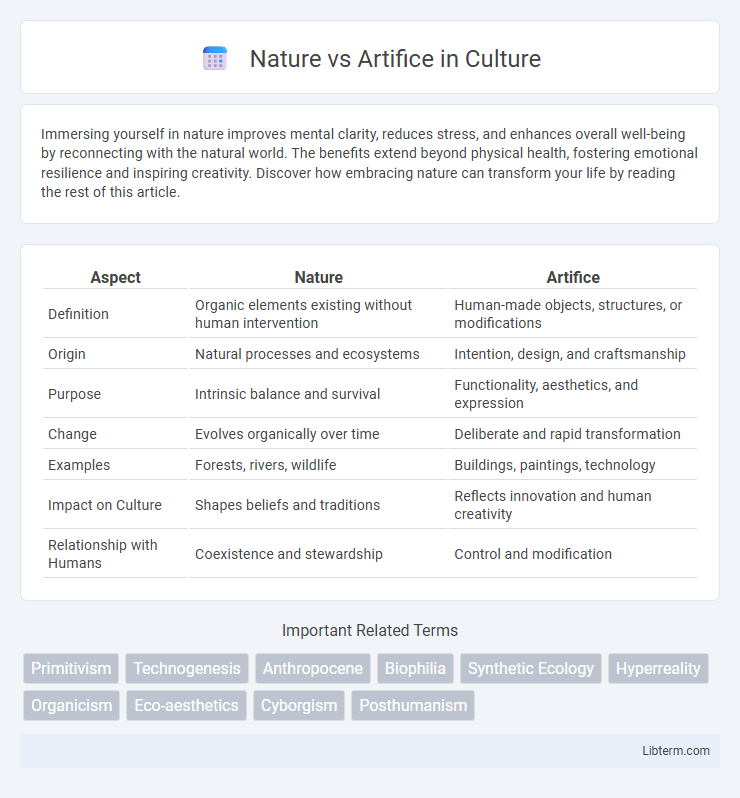Immersing yourself in nature improves mental clarity, reduces stress, and enhances overall well-being by reconnecting with the natural world. The benefits extend beyond physical health, fostering emotional resilience and inspiring creativity. Discover how embracing nature can transform your life by reading the rest of this article.
Table of Comparison
| Aspect | Nature | Artifice |
|---|---|---|
| Definition | Organic elements existing without human intervention | Human-made objects, structures, or modifications |
| Origin | Natural processes and ecosystems | Intention, design, and craftsmanship |
| Purpose | Intrinsic balance and survival | Functionality, aesthetics, and expression |
| Change | Evolves organically over time | Deliberate and rapid transformation |
| Examples | Forests, rivers, wildlife | Buildings, paintings, technology |
| Impact on Culture | Shapes beliefs and traditions | Reflects innovation and human creativity |
| Relationship with Humans | Coexistence and stewardship | Control and modification |
Defining Nature and Artifice
Nature encompasses naturally occurring elements and processes in the physical world, including ecosystems, biological organisms, and geological formations shaped without human intervention. Artifice refers to human-made constructs and modifications, such as technology, architecture, and synthetic materials designed to replicate or alter natural conditions. The distinction between nature and artifice centers on origin and intent, with nature arising spontaneously and artifice resulting from deliberate human creativity and manipulation.
Historical Perspectives on Nature vs Artifice
Historical perspectives on nature versus artifice reveal a longstanding debate dating back to ancient Greek philosophy, where thinkers like Aristotle emphasized the natural order as essential to human purpose. During the Renaissance, the rise of humanism shifted focus towards human creativity and artifice, valuing innovation and craftsmanship as extensions of nature. The Enlightenment further challenged traditional views by promoting reason and scientific progress, blurring the boundary between natural phenomena and artificial constructs.
The Philosophical Debate
The nature versus artifice debate explores the distinctions and tensions between what is inherent in the natural world and what is human-made or artificial. Philosophers analyze how human intervention shapes reality, questioning authenticity, morality, and the essence of existence. This discourse challenges the boundaries of natural order and cultural constructs, influencing ethics, epistemology, and environmental philosophy.
Nature in Literature and Art
Nature in literature and art symbolizes purity, growth, and the inherent rhythms of life, often depicted through lush landscapes, flora, and fauna. Writers and artists use natural imagery to explore human emotions, spiritual connections, and the contrast between organic life and human-made environments. This motif highlights the enduring power of the natural world, serving as a source of inspiration and a critique of technological and industrial encroachment.
Human Intervention: Progress or Disruption?
Human intervention in natural processes often drives technological progress by enhancing resource management, medical advancements, and environmental restoration. However, excessive manipulation can disrupt ecosystems, leading to biodiversity loss and ecological imbalance. Evaluating whether human action constitutes progress or disruption depends on the sustainability and long-term impact of these interventions on nature.
Technology’s Role in Shaping Environments
Technology shapes environments by transforming natural landscapes into engineered spaces through urban development, agricultural innovation, and infrastructure projects. Advanced tools like GIS mapping, environmental sensors, and sustainable design technologies enable precise management and modification of ecosystems to meet human needs. These interventions blur the line between nature and artifice, creating hybrid environments where technological influence dictates ecological and social dynamics.
The Aesthetics of Natural vs Artificial
The aesthetics of natural versus artificial materials reveal distinct sensory and emotional responses, with natural elements often evoking authenticity, organic complexity, and biophilic connection. Artificial designs emphasize precision, symmetry, and innovative manipulation of form, offering controlled beauty and futuristic appeal. This contrast highlights the evolving relationship between human creativity and the intrinsic patterns of the natural world.
Ethics of Altering Nature
Altering nature through genetic engineering and synthetic biology raises critical ethical questions about human intervention in ecosystems and biodiversity. The potential benefits of modifying organisms for agriculture, medicine, and environmental restoration must be weighed against risks such as unintended ecological consequences and moral considerations of 'playing God.' Ethical frameworks emphasize the importance of precaution, transparency, and respect for natural systems to guide responsible scientific innovation.
Case Studies: Nature and Artifice in Practice
Case studies exploring Nature vs Artifice reveal dynamic interactions between natural environments and human-made interventions, highlighting adaptive strategies in ecological restoration and urban design. Projects like the High Line in New York integrate native plant species within constructed frameworks, demonstrating harmonious coexistence. These examples showcase innovation in blending organic systems with artificial structures, optimizing sustainability and aesthetic value.
Future Implications and the Path Forward
Exploring the tension between nature and artifice reveals critical future implications for sustainable development and technological innovation. Emphasizing biomimicry and eco-friendly technologies can drive progress while minimizing environmental impact. Strategic integration of natural principles with artificial advancements fosters resilient ecosystems and adaptive human societies.
Nature Infographic

 libterm.com
libterm.com